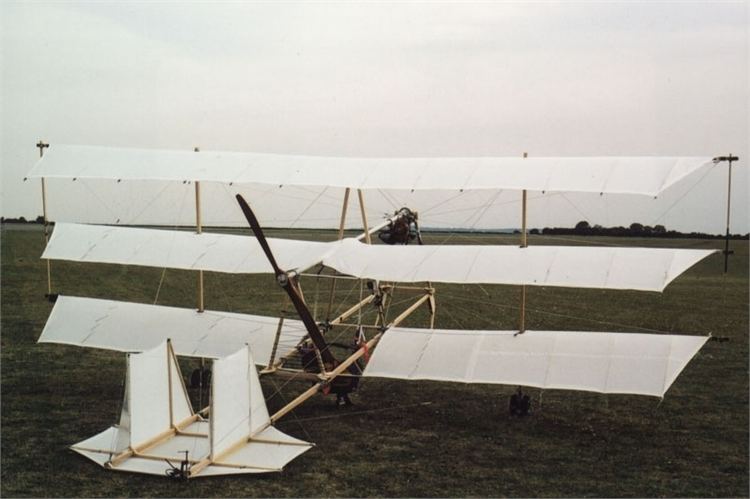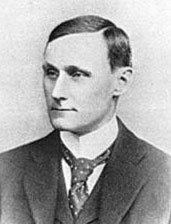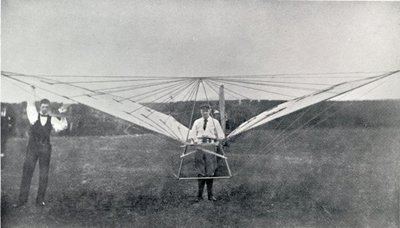Name Percy Pilcher | Role Inventor | |
 | ||
Died October 2, 1899, London, United Kingdom | ||
Percy pilcher
Percy Sinclair Pilcher (16 January 1866 – 2 October 1899) was a British inventor and pioneer aviator who was his country's foremost experimenter in unpowered flight at the end of the nineteenth century.
Contents

He was planning a flight with a motor-driven hang glider, but died in the crash of another glider before he could make the attempt.

His memorial is in a field opposite Stanford Hall.

Percy pilchers flying machine
Early life

Percy Pilcher was born in Bath in 1866, and served in the Royal Navy for seven years from 1880. Thereafter he became an apprentice with the shipbuilders, Randolph, Elder and Company, of Govan in Glasgow.
Career
In 1891 Pilcher began work as assistant lecturer at Glasgow University and took a growing interest in aviation. He built a hang glider called The Bat which he flew for the first time in 1895;
Later that year Pilcher met Otto Lilienthal, who was the leading expert in gliding in Germany. These discussions led to Pilcher building two more gliders, The Beetle and The Gull. Based on the work of his mentor Otto Lilienthal, in 1897 Pilcher built a glider called The Hawk with which he broke the world distance record when he flew 250 m (820 ft) at the grounds of Stanford Hall near Lutterworth in Leicestershire, England.
Pilcher set his sights upon powered flight: he developed a triplane that was to be powered by a 4 hp (3 kW) engine; however, construction of the triplane put him heavily into debt, and Pilcher needed sponsorship to complete his work.
Pilcher formed a company with Walter Gordon Wilson, who was later to become a successful motor engineer and credited by the 1919 Royal Commission on Awards to Inventors as the co-inventor of the tank, along with Sir William Tritton.
Death
On 30 September 1899, having completed his triplane, he had intended to demonstrate it to a group of onlookers and potential sponsors in a field near Stanford Hall. However, days before, the engine crankshaft had broken and, so as not to disappoint his guests, he decided to fly the Hawk instead. The weather was stormy and rainy, but by 4 pm Pilcher decided the weather was good enough to fly. Whilst flying, the tail snapped and Pilcher plunged 10 metres (30 ft) to the ground: he died two days later from his injuries with his triplane having never been publicly flown.
He is buried in Brompton Cemetery, west London.
Legacy
A stone monument to him stands in the field near Stanford Hall at the point where he crashed, and a full-sized replica of his "The Hawk" glider is also displayed at Stanford Hall. The original Hawk has survived and is in the collections of National Museums Scotland.
Pilcher is one of the unsuccessful aviation pioneers mentioned in the Marc Blitzstein composition The Airborne Symphony.
In 2011 he was one of seven inaugural inductees to the Scottish Engineering Hall of Fame.
Renewal of interest
Pilcher's plans were lost for many years, and his name was also long forgotten except by a few enthusiasts. When the centenary of the Wright brothers' flight approached, a new effort was made to find the lost work, and some correspondence was found in a private American collection. From this it was possible to discern the general direction of his plans and the basis of his design. Based on Lilienthal's work, Pilcher understood how to produce lift using winglike structures, but at this time a full mathematical description was years away, so many elements were still missing.
In particular, Pilcher was stuck trying to design a wing that could lift the weight of an engine, the aircraft itself and the occupant – each increase in wing area increased the weight so much that yet more lift was required, requiring a larger wing – a seemingly vicious circle. Pilcher's breakthrough, thanks to correspondence with another pioneer, Octave Chanute, was to stack smaller, lighter wings one atop the other in an arrangement we know today as the biplane or triplane. This allowed the wings to generate much more lift without a corresponding increase in weight.
In 2003, a research effort carried out at the School of Aeronautics at Cranfield University, commissioned by the BBC2 television series "Horizon", has shown that Pilcher's design was more or less workable, and had he been able to develop his engine, it is possible he would have succeeded in being the first to fly a heavier-than-air powered aircraft with some degree of control.
Cranfield built a replica of Pilcher's aircraft and added the Wright brothers' innovation of wing-warping as a safety backup for roll control. Pilcher's original design did not include aerodynamic controls such as ailerons or elevator. After a very short initial test flight piloted by the aircraft designer Bill Brookes, the craft achieved a sustained flight of 1 minute and 25 seconds, compared to 59 seconds for the Wright Brothers' best flight at Kitty Hawk. This was achieved under dead calm conditions as an additional safety measure; the Wrights in 1903 flew in a 20 mph+ wind to achieve sufficient airspeed.
